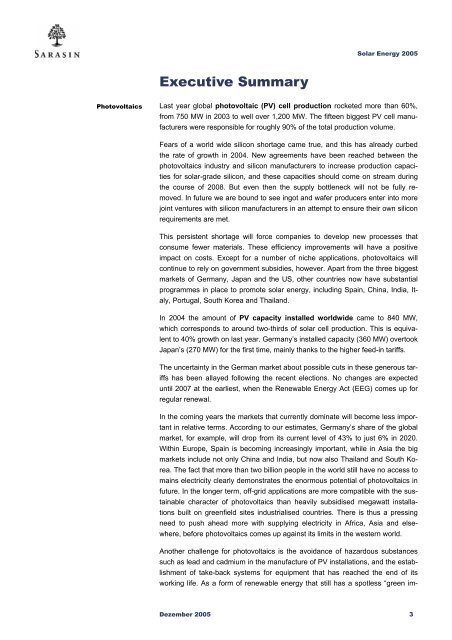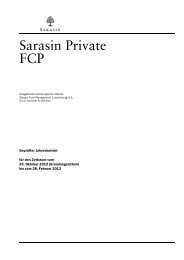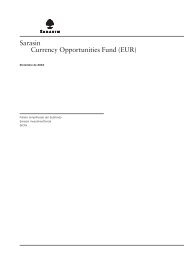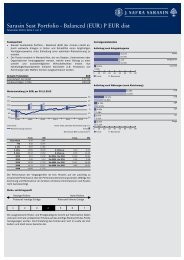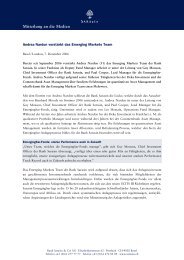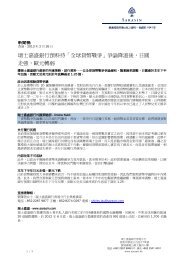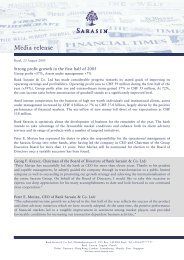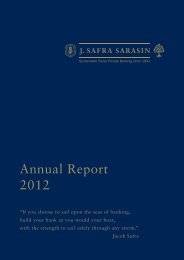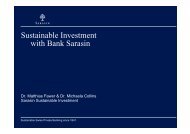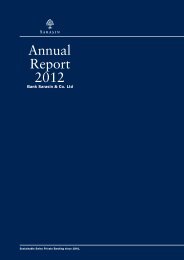Sustainability Report - Bank Sarasin-Alpen
Sustainability Report - Bank Sarasin-Alpen
Sustainability Report - Bank Sarasin-Alpen
You also want an ePaper? Increase the reach of your titles
YUMPU automatically turns print PDFs into web optimized ePapers that Google loves.
Solar Energy 2005<br />
Executive Summary<br />
Photovoltaics<br />
Last year global photovoltaic (PV) cell production rocketed more than 60%,<br />
from 750 MW in 2003 to well over 1,200 MW. The fifteen biggest PV cell manufacturers<br />
were responsible for roughly 90% of the total production volume.<br />
Fears of a world wide silicon shortage came true, and this has already curbed<br />
the rate of growth in 2004. New agreements have been reached between the<br />
photovoltaics industry and silicon manufacturers to increase production capacities<br />
for solar-grade silicon, and these capacities should come on stream during<br />
the course of 2008. But even then the supply bottleneck will not be fully removed.<br />
In future we are bound to see ingot and wafer producers enter into more<br />
joint ventures with silicon manufacturers in an attempt to ensure their own silicon<br />
requirements are met.<br />
This persistent shortage will force companies to develop new processes that<br />
consume fewer materials. These efficiency improvements will have a positive<br />
impact on costs. Except for a number of niche applications, photovoltaics will<br />
continue to rely on government subsidies, however. Apart from the three biggest<br />
markets of Germany, Japan and the US, other countries now have substantial<br />
programmes in place to promote solar energy, including Spain, China, India, Italy,<br />
Portugal, South Korea and Thailand.<br />
In 2004 the amount of PV capacity installed worldwide came to 840 MW,<br />
which corresponds to around two-thirds of solar cell production. This is equivalent<br />
to 40% growth on last year. Germany’s installed capacity (360 MW) overtook<br />
Japan’s (270 MW) for the first time, mainly thanks to the higher feed-in tariffs.<br />
The uncertainty in the German market about possible cuts in these generous tariffs<br />
has been allayed following the recent elections. No changes are expected<br />
until 2007 at the earliest, when the Renewable Energy Act (EEG) comes up for<br />
regular renewal.<br />
In the coming years the markets that currently dominate will become less important<br />
in relative terms. According to our estimates, Germany’s share of the global<br />
market, for example, will drop from its current level of 43% to just 6% in 2020.<br />
Within Europe, Spain is becoming increasingly important, while in Asia the big<br />
markets include not only China and India, but now also Thailand and South Korea.<br />
The fact that more than two billion people in the world still have no access to<br />
mains electricity clearly demonstrates the enormous potential of photovoltaics in<br />
future. In the longer term, off-grid applications are more compatible with the sustainable<br />
character of photovoltaics than heavily subsidised megawatt installations<br />
built on greenfield sites industrialised countries. There is thus a pressing<br />
need to push ahead more with supplying electricity in Africa, Asia and elsewhere,<br />
before photovoltaics comes up against its limits in the western world.<br />
Another challenge for photovoltaics is the avoidance of hazardous substances<br />
such as lead and cadmium in the manufacture of PV installations, and the establishment<br />
of take-back systems for equipment that has reached the end of its<br />
working life. As a form of renewable energy that still has a spotless “green im-<br />
Dezember 2005 3


